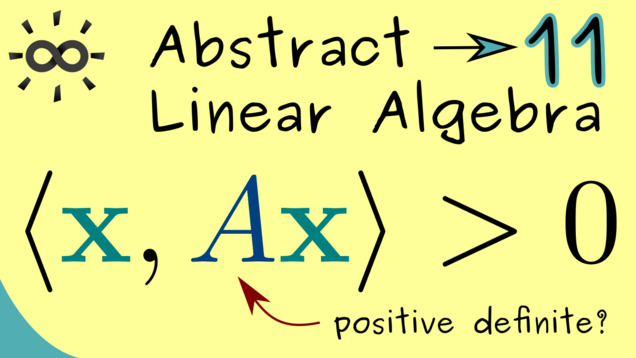
-
Title: Positive Definite Matrices
-
Series: Abstract Linear Algebra
-
Chapter: General inner products
-
YouTube-Title: Abstract Linear Algebra 11 | Positive Definite Matrices
-
Bright video: https://youtu.be/ZuOrdYMkQmU
-
Dark video: https://youtu.be/e5Q8VGC4Zwc
-
Quiz: Test your knowledge
-
Dark-PDF: Download PDF version of the dark video
-
Print-PDF: Download printable PDF version
-
Thumbnail (bright): Download PNG
-
Thumbnail (dark): Download PNG
-
Subtitle on GitHub: ala11_sub_eng.srt missing
-
Timestamps (n/a)
-
Subtitle in English (n/a)
-
Quiz Content
Q1: Which matrix $A \in \mathbb{C}^{2 \times 2}$ is clearly not positive definite?
A1: $ A = \begin{pmatrix} 1 & 1 \ 0 & 1 \end{pmatrix} $
A2: $ A = \begin{pmatrix} 1 & 0 \ 0 & 1 \end{pmatrix} $
A3: $ A = \begin{pmatrix} 5 & 1 \ 1 & 1 \end{pmatrix} $
A4: $ A = \begin{pmatrix} 2 & 3 \ 3 & 5 \end{pmatrix} $
Q2: What is not equivalent for $A = \begin{pmatrix} a_{11} & a_{12} \ a_{21} & a_{22} \end{pmatrix} \in \mathbb{C}^{2 \times 2}$ being a positive-definite matrix?
A1: $a_{11} > 0$ and $ \det(A) > 0$.
A2: $A$ is selfadjoint and $\langle x, A x \rangle_{standard} > 0 $ for all $x \in \mathbb{C}^2 \setminus { 0 } $.
A3: $A$ is selfadjoint and all eigenvalues are positive.
A4: $\langle x, A x \rangle_{\text{standard}} > 0 $ for all $x \in \mathbb{C}^2 \setminus { 0 } $.
Q3: Apply a Gaussian step to the matrix $A = \begin{pmatrix} 2 & 1 \ 1 & 1 \end{pmatrix}$ that is allowed according to the video such that one can check if $A$ is positive definite. Which matrix do we get?
A1: $A = \begin{pmatrix} 2 & 1 \ 0 & \frac{1}{2} \end{pmatrix}$
A2: $A = \begin{pmatrix} - 1 & -\frac{1}{2} \ 1 & 1 \end{pmatrix}$
A3: $A = \begin{pmatrix} 1 & 1 \ 2 & 1 \end{pmatrix}$
A4: $A = \begin{pmatrix} 2 & 1 \ -2 & -2 \end{pmatrix}$
-
Last update: 2024-11